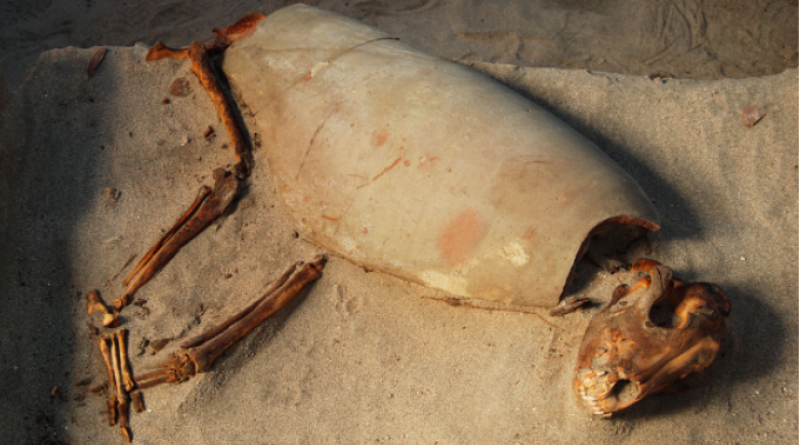Graves of nearly 600 cats and dogs in ancient Egypt may be world’s oldest pet cemetery.

The cats and dogs lie as if asleep, in individual graves. Many wore collars or other adornments, and they had been cared for through injury and old age, like today’s pets. But the last person to bury a beloved animal companion in this arid Egyptian land on the coast of the Red Sea did so nearly 2000 years ago.
The site, located in the early Roman port of Berenice, was found 10 years ago, but its purpose was mysterious. Now, a detailed excavation has unearthed the burials of nearly 600 cats and dogs, along with the strongest evidence yet that these animals were treasured pets. That would make the site the oldest known pet cemetery, the authors argue, suggesting the modern concept of pets wasn’t alien to the ancient world.
“I’ve never encountered a cemetery like this,” says Michael MacKinnon, a zooarchaeologist at the University of Winnipeg who has studied the role of animals across the bygone Mediterranean but was not involved with the new work. “The idea of pets as part of the family is hard to get at in antiquity, but I think they were [family] here.”
Archaeozoologist Marta Osypinska and her colleagues at the Polish Academy of Sciences discovered the graveyard just outside the city walls, beneath a Roman trash dump, in 2011. The cemetery appears to have been used between the first and second centuries C.E., when Berenice was a bustling Roman port that traded ivory, fabrics, and other luxury goods from India, Arabia, and Europe.
In 2017, Osypinska’s team reported unearthing the remains of about 100 animals—mostly cats—which appear to have been cared for like pets. But the exact nature of the site wasn’t clear. Salima Ikram, an expert on ancient Egyptian animals at the American University in Cairo, said at the time that the bones might have been discarded rubbish.
Osypinska and her colleagues have now excavated the remains of 585 animals from the site and analyzed the bones in detail. A veterinarian helped the team determine health, diet, and cause of death.
The animals appear to have been laid gently in well-prepared pits. Many were covered with textiles or pieces of pottery, “which formed a kind of sarcophagus,” Osypinska says. More than 90% were cats, many wearing iron collars or necklaces threaded with glass and shells. One feline was placed on the wing of a large bird.
The team found no evidence of mummification, sacrifice, or other ritual practices seen at ancient animal burial places such as the Ashkelon site in Israel. At Berenice, most of the animals appear to have died from injury or disease. Some cats have fractured legs or other breaks that may have been caused by falls or from being kicked by a horse. Others died young, possibly from infectious diseases that spread rapidly in the cramped city.
The dogs, which make up only about 5% of the burials (the rest are monkeys), tended to be older when they died. Many had lost most of their teeth or suffered periodontal disease and joint degeneration.
“We have individuals who have very limited mobility,” Osypinska says. Yet many lived long lives and their injuries healed. “Such animals had to be fed to survive,” she says, “sometimes with special foods in the case of the almost-toothless animals.”
The fact that humans took such good care of the animals, especially in a rough-and-tumble region where almost all resources had to be imported—and that they took such care in burying them, just as many modern owners do—suggests the people of Berenice had a strong emotional bond with their cats and dogs, the team concluded last month in World Archaeology. “They weren’t doing it for the gods or for any utilitarian benefit,” Osypinska says. Instead, she argues that the relationship between people and their pets was “surprisingly close” to the one we see today.
Ikram is convinced. “This is a cemetery,” she says. “And it sheds an interesting light on the inhabitants of Berenice and their relationships with their animals.”
Archaeologist Wim Van Neer is also on board. “I’ve never seen a cat with a collar” from so long ago, says Van Neer, of the Royal Belgian Institute of Natural Sciences, who has studied the relationship between people and animals in the ancient world, including at Berenice.
Still, he says it’s possible the people of Berenice valued their cats and dogs for nonsentimental reasons. A seaport would have teemed with rats, he notes, making cats a prized working animal. And although a few of the pups at the site were small dogs akin to today’s toy breeds—and thus likely had little utility except as lap dogs—larger canines could have guarded homes and consumed refuse. “I don’t believe it was just a loving relationship.”
Osypinska hopes the new work will convince other archaeologists that companion animals are worth study. “At first, some very experienced archaeologists discouraged me from this research,” arguing the pets were irrelevant for understanding the lives of ancient peoples, she says. “I hope the results of our studies prove that it’s worth it.”
26 February 2021
science





